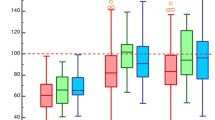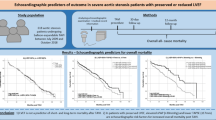Abstract
Objectives
Aortic valve calcification (AVC) determined by computed tomography has emerged as a complementary measure of aortic stenosis (AS) severity and as a predictor of adverse events. Thus, AVC can guide further treatment decisions in patients with low-gradient AS (LG-AS). We compared the symptomatic and prognostic outcome of patients with low vs. high AVC after transcatheter aortic valve implantation (TAVI).
Methods
Patients with an aortic valve area index ≤ 0.6 cm2/m2 and a mean pressure gradient (MPG) < 40 mmHg were classified as low-flow, low-gradient AS (LFLG-AS; stroke volume index [SVI] ≤ 35 ml/m2, left ventricular ejection fraction [LVEF] < 50%, n = 173), paradoxical LFLG-AS (pLFLG-AS, SVI ≤ 35 ml/m2, LVEF ≥ 50%, n = 233), or normal-flow, low-gradient AS (NFLG-AS, SVI > 35 ml/m2, LVEF ≥ 50%, n = 244); patients with MPG ≥ 40 mmHg (n = 1142) served as controls. Patients were further categorized according to published AVC thresholds.
Results
Demographic characteristics and cardiovascular risk were not different between patients with high vs. low AVC in any of the subgroups. Patients with low AVC had a lower MPG. Symptom improvement at 30 days was observed in the majority of patients but was less pronounced in LFLG-AS patients with low vs. those with high AVC. Kaplan-Meier 1-year survival curves were identical between patients with low and high AVC in all three LG-AS groups.
Conclusions
The severity of LG-AS based on AVC has no impact on 1-year prognosis once TAVI has been performed.
Key Points
• Aortic valve calcification (AVC) determined by computed tomography has emerged as a complementary measure of aortic stenosis (AS) severity and is of prognostic value in selected patients.
• Patients with inconsistent echocardiographic measures can be classified as having severe or nonsevere AS by the computed tomography–derived AVC score.
• The prognostic value of AVC in patients with low-gradient AS is abrogated after correction of afterload by TAVI.


Similar content being viewed by others
Abbreviations
- AS:
-
Aortic stenosis
- AVA:
-
Aortic valve area
- AVC:
-
Aortic valve calcification
- AVCd:
-
AVC density
- LFLG:
-
Low flow, low gradient
- LG:
-
Low gradient
- LV:
-
Left ventricular
- LVEF:
-
Left ventricular ejection fraction
- MPG:
-
Transvalvular mean pressure gradient
- NFLG:
-
Normal flow, low gradient
- NYHA:
-
New York Heart Association
- pLFLG:
-
Paradoxical low flow, low gradient
- SV:
-
Stroke volume
- SVI:
-
Stroke volume index
- TAVI:
-
Transcatheter aortic valve implantation
References
Clavel MA, Burwash IG, Pibarot P (2017) Cardiac imaging for assessing low-gradient severe aortic stenosis. JACC Cardiovasc Imaging 10(2):185–202
Clavel MA, Messika-Zeitoun D, Pibarot P et al (2013) The complex nature of discordant severe calcified aortic valve disease grading: new insights from combined Doppler echocardiographic and computed tomographic study. J Am Coll Cardiol 62(24):2329–2338
Pawade T, Clavel MA, Tribouilloy C et al (2018) Computed tomography aortic valve calcium scoring in patients with aortic stenosis. Circ Cardiovasc Imaging 11(3):e007146
Baumgartner H, Falk V, Bax JJ et al (2017) 2017 ESC/EACTS guidelines for the management of valvular heart disease. Eur Heart J 38(36):2739–2791
Abramowitz Y, Jilaihawi H, Pibarot P et al (2017) Severe aortic stenosis with low aortic valve calcification: characteristics and outcome following transcatheter aortic valve implantation. Eur Heart J Cardiovasc Imaging 18(6):639–647
Kappetein AP, Head SJ, Genereux P et al (2012) Updated standardized endpoint definitions for transcatheter aortic valve implantation: the Valve Academic Research Consortium-2 consensus document (VARC-2). Eur J Cardiothorac Surg 42(5):S45–S60
Lang RM, Badano LP, Mor-Avi V et al (2015) Recommendations for cardiac chamber quantification by echocardiography in adults: an update from the American Society of Echocardiography and the European Association of Cardiovascular Imaging. Eur Heart J Cardiovasc Imaging 16(3):233–270
Baumgartner H, Hung J, Bermejo J et al (2017) Recommendations on the echocardiographic assessment of aortic valve stenosis: a focused update from the European Association of Cardiovascular Imaging and the American Society of Echocardiography. J Am Soc Echocardiogr 30(4):372–392
Blaha MJ, Budoff MJ, Rivera JJ et al (2010) Relation of aortic valve calcium detected by cardiac computed tomography to all-cause mortality. Am J Cardiol 106(12):1787–1791
Nchimi A, Dibato JE, Davin L, Schoysman L, Oury C, Lancellotti P (2018) Predicting disease progression and mortality in aortic stenosis: a systematic review of imaging biomarkers and meta-analysis. Front Cardiovasc Med 5:112
Clavel MA, Pibarot P, Messika-Zeitoun D et al (2014) Impact of aortic valve calcification, as measured by MDCT, on survival in patients with aortic stenosis: results of an international registry study. J Am Coll Cardiol 64(12):1202–1213
Cueff C, Serfaty JM, Cimadevilla C et al (2011) Measurement of aortic valve calcification using multislice computed tomography: correlation with haemodynamic severity of aortic stenosis and clinical implication for patients with low ejection fraction. Heart 97(9):721–726
Carabello BA (2013) Introduction to aortic stenosis. Circ Res 113(2):179–185
Di Minno MND, Poggio P, Conte E et al (2019) Cardiovascular morbidity and mortality in patients with aortic valve calcification: a systematic review and meta-analysis. J Cardiovasc Comput Tomogr 13(4):190–195
Kamperidis V, de Graaf MA, Broersen A et al (2014) Prognostic value of aortic and mitral valve calcium detected by contrast cardiac computed tomography angiography in patients with suspicion of coronary artery disease. Am J Cardiol 113(5):772–778
Messika-Zeitoun D, Bielak LF, Peyser PA et al (2007) Aortic valve calcification: determinants and progression in the population. Arterioscler Thromb Vasc Biol 27(3):642–648
Khalique OK, Hahn RT, Gada H et al (2014) Quantity and location of aortic valve complex calcification predicts severity and location of paravalvular regurgitation and frequency of post-dilation after balloon-expandable transcatheter aortic valve replacement. JACC Cardiovasc Interv 7(8):885–894
Ribeiro HB, Orwat S, Hayek SS et al (2016) Cardiovascular magnetic resonance to evaluate aortic regurgitation after transcatheter aortic valve replacement. J Am Coll Cardiol 68(6):577–585
Koos R, Reinartz S, Mahnken AH et al (2013) Impact of aortic valve calcification severity and impaired left ventricular function on 3-year results of patients undergoing transcatheter aortic valve replacement. Eur Radiol 23(12):3253–3261
Amabile N, Agostini H, Gilard M et al (2014) Impact of low preprocedural transvalvular gradient on cardiovascular mortality following TAVI: an analysis from the FRANCE 2 registry. EuroIntervention 10(7):842–849
Conrotto F, D’Ascenzo F, D’Amico M et al (2017) Outcomes of patients with low-pressure aortic gradient undergoing transcatheter aortic valve implantation: a meta-analysis. Catheter Cardiovasc Interv 89(6):1100–1106
Fischer-Rasokat U, Renker M, Liebetrau C et al (2019) 1-year survival after TAVR of patients with low-flow, low-gradient and high-gradient aortic valve stenosis in matched study populations. JACC Cardiovasc Interv 12(8):752–763
Kempny A, Diller GP, Kaleschke G et al (2013) Longitudinal left ventricular 2D strain is superior to ejection fraction in predicting myocardial recovery and symptomatic improvement after aortic valve implantation. Int J Cardiol 167(5):2239–2243
Herrmann S, Stork S, Niemann M et al (2011) Low-gradient aortic valve stenosis myocardial fibrosis and its influence on function and outcome. J Am Coll Cardiol 58(4):402–412
Herrmann S, Fries B, Salinger T et al (2018) Myocardial fibrosis predicts 10-year survival in patients undergoing aortic valve replacement. Circ Cardiovasc Imaging 11(8):e007131
Nara Y, Kataoka A, Watanabe Y et al (2019) Prognostic impact of postprocedure stroke volume in patients with low-gradient aortic stenosis. Open Heart 6(1):e000988
Lancellotti P, Magne J, Donal E et al (2012) Clinical outcome in asymptomatic severe aortic stenosis: insights from the new proposed aortic stenosis grading classification. J Am Coll Cardiol 59(3):235–243
Eleid MF, Sorajja P, Michelena HI, Malouf JF, Scott CG, Pellikka PA (2013) Flow-gradient patterns in severe aortic stenosis with preserved ejection fraction: clinical characteristics and predictors of survival. Circulation 128(16):1781–1789
Dayan V, Vignolo G, Magne J, Clavel MA, Mohty D, Pibarot P (2015) Outcome and impact of aortic valve replacement in patients with preserved LVEF and low-gradient aortic stenosis. J Am Coll Cardiol 66(23):2594–2603
Sato K, Kumar A, Jobanputra Y et al (2019) Association of time between left ventricular and aortic systolic pressure peaks with severity of aortic stenosis and calcification of aortic valve. JAMA Cardiol 4(6):549–555
Acknowledgments
We thank Elizabeth Martinson for excellent editorial work.
Funding
The authors state that this work has not received any funding.
Author information
Authors and Affiliations
Corresponding author
Ethics declarations
Guarantor
The scientific guarantor of this publication is Ulrich Fischer-Rasokat.
Conflict of interest
The authors of this manuscript declare relationships with the following companies:
Ulrich Fischer-Rasokat: no personal disclosures in relation to the manuscript
Matthias Renker: speaker fees from St. Jude Medical, Abbott
Christoph Liebetrau: speaker fees from Abbott
Maren Weferling: no personal disclosures in relation to the manuscript
Andreas Rolf: no personal disclosures in relation to the manuscript
Mirko Doss: proctor fees for Boston Scientific
Helge Möllmann: proctor/speaker fees from Abbott, Biotronik, Boston Scientific, Edwards Lifesciences, St. Jude Medical
Thomas Walther: no personal disclosures in relation to the manuscript
Christian W. Hamm: advisory board Medtronic
Won-Keun Kim: proctor/speaker fees from Boston Scientific, Abbott, St. Jude Medical, Edwards Lifesciences
Statistics and biometry
No complex statistical methods were necessary for this paper.
Informed consent
Written informed consent was waived by the Institutional Review Board.
Ethical approval
Institutional Review Board approval was obtained.
Study subjects or cohorts overlap
Some study subjects or cohorts have been previously reported in publications from our study group.
Methodology
• retrospective
• observational
• performed at one institution
Additional information
Publisher’s note
Springer Nature remains neutral with regard to jurisdictional claims in published maps and institutional affiliations.
Rights and permissions
About this article
Cite this article
Fischer-Rasokat, U., Renker, M., Liebetrau, C. et al. Does the severity of low-gradient aortic stenosis classified by computed tomography–derived aortic valve calcification determine the outcome of patients after transcatheter aortic valve implantation (TAVI)?. Eur Radiol 31, 549–558 (2021). https://doi.org/10.1007/s00330-020-07121-z
Received:
Revised:
Accepted:
Published:
Issue Date:
DOI: https://doi.org/10.1007/s00330-020-07121-z




